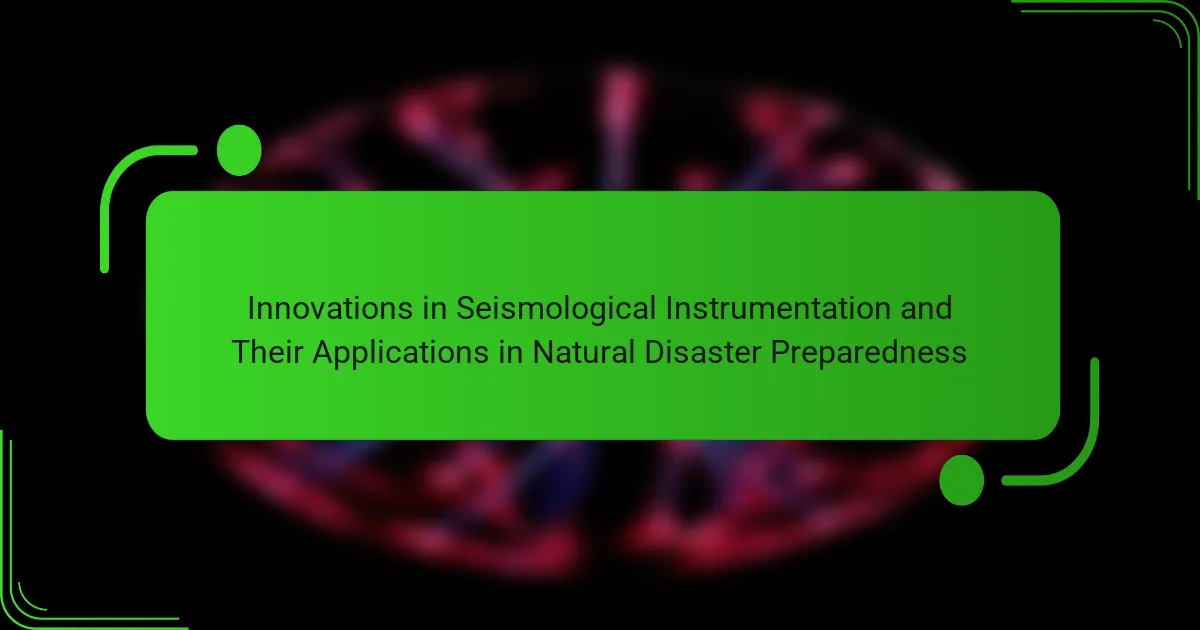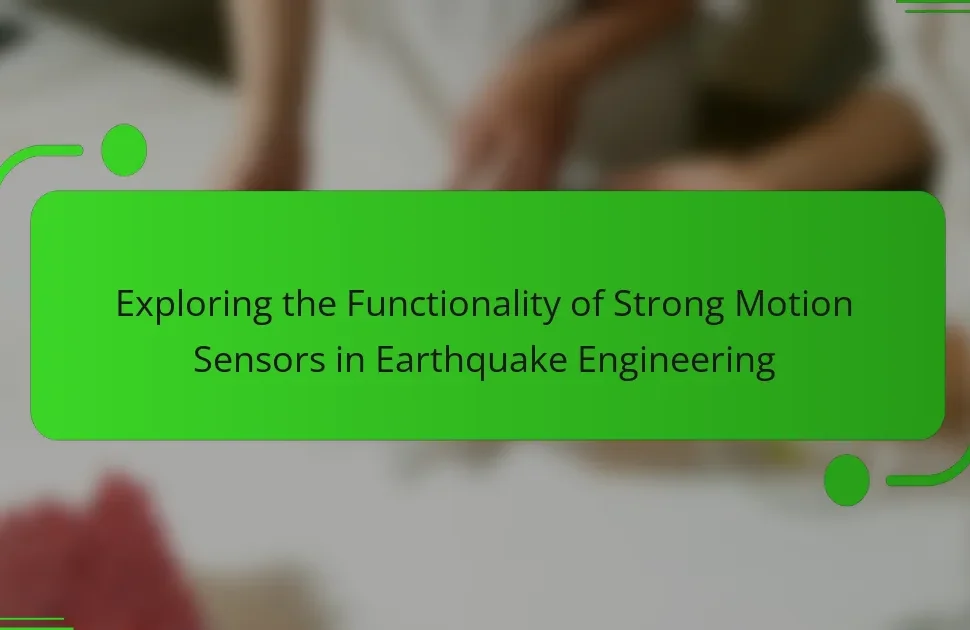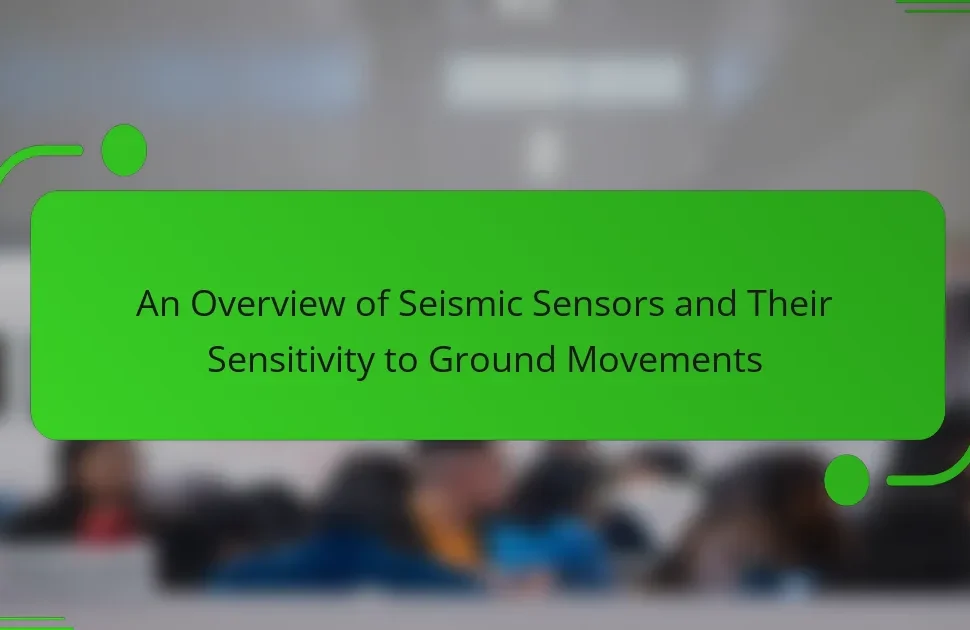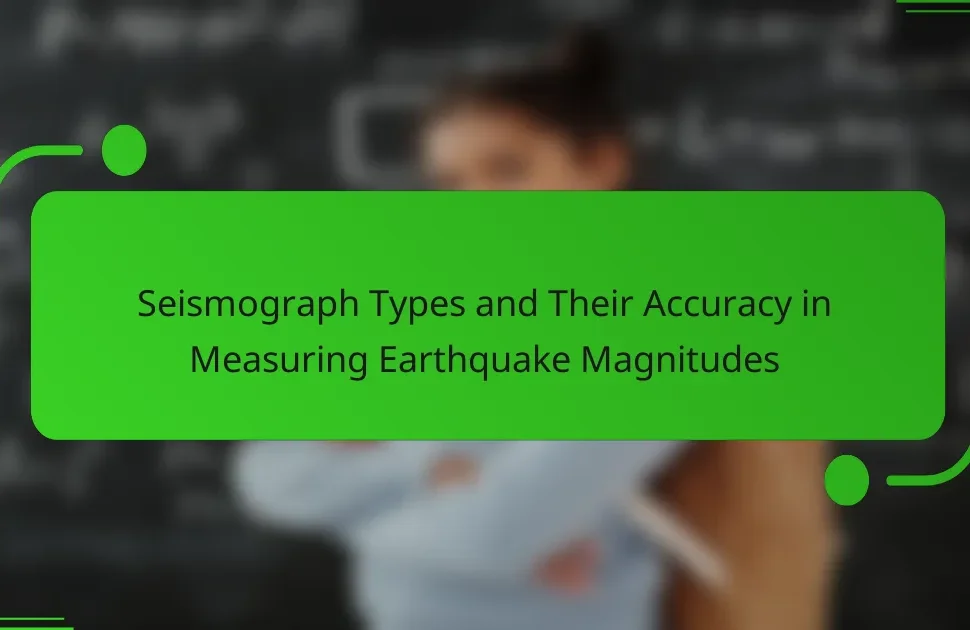Innovations in seismological instrumentation encompass advanced sensors, real-time data processing, and improved communication systems, all aimed at enhancing earthquake detection and monitoring. Key technologies include fiber-optic sensors for precise ground movement detection, machine learning algorithms for efficient data analysis, and wireless networks for rapid data transmission from remote areas. These advancements are vital for natural disaster preparedness, providing real-time data that aids in predicting earthquakes and assessing their impacts. Future trends suggest further integration of sensor technologies and satellite-based systems, which will improve prediction accuracy and community engagement in disaster response strategies. Overall, these innovations play a crucial role in minimizing damage and saving lives during seismic events.
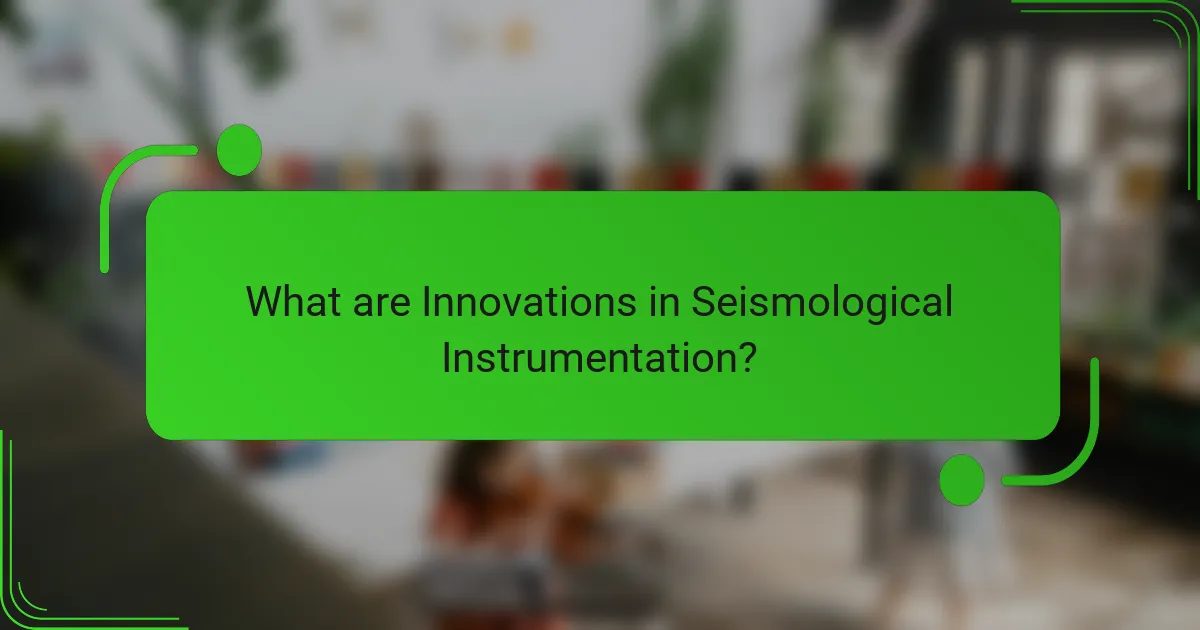
What are Innovations in Seismological Instrumentation?
Innovations in seismological instrumentation include advanced sensors, real-time data processing, and improved communication systems. These innovations enhance earthquake detection and monitoring capabilities. For instance, fiber-optic sensors can detect ground movement with high precision. Additionally, machine learning algorithms analyze seismic data more efficiently. Wireless networks enable rapid data transmission from remote locations. Innovations also include portable seismic devices for field studies. These advancements contribute to better earthquake preparedness and response strategies. They are crucial for minimizing damage and saving lives during seismic events.
How have recent advancements improved seismological instrumentation?
Recent advancements have significantly improved seismological instrumentation. Enhanced sensor technology has increased the sensitivity and accuracy of seismic measurements. For example, broadband seismometers can now detect smaller tremors than previous models. Innovations in data processing algorithms allow for real-time analysis of seismic data. This leads to quicker and more reliable earthquake detection. Additionally, the integration of GPS technology improves the ability to monitor ground movement. Wireless communication systems facilitate faster data transmission from remote locations. These advancements collectively enhance earthquake preparedness and response efforts.
What new technologies are being utilized in seismological instruments?
New technologies in seismological instruments include advanced sensors, machine learning algorithms, and real-time data processing systems. Advanced sensors, such as fiber optic sensors, provide high-resolution data on seismic activities. Machine learning algorithms enhance the ability to predict earthquakes by analyzing large datasets. Real-time data processing systems allow for immediate analysis and dissemination of seismic information. These innovations improve the accuracy of earthquake detection and monitoring. For instance, the incorporation of GPS technology helps in measuring ground deformation. The use of drones is also emerging for remote monitoring of seismic activity. These technologies collectively enhance natural disaster preparedness and response strategies.
How do these advancements enhance data accuracy?
Advancements in seismological instrumentation enhance data accuracy by utilizing high-precision sensors and advanced algorithms. These sensors detect even the smallest seismic waves, improving sensitivity. Enhanced algorithms process data in real-time, reducing noise and increasing clarity. This combination allows for more reliable earthquake detection and characterization. For instance, the use of broadband seismometers has been shown to increase the accuracy of magnitude estimates by up to 30%. Additionally, integration with GPS technology provides precise location data, further refining measurements. Overall, these innovations lead to better-informed disaster preparedness and response strategies.
Why is innovation crucial in seismological instrumentation?
Innovation is crucial in seismological instrumentation to enhance the accuracy and reliability of earthquake detection. Advanced technologies improve data collection methods, leading to better real-time monitoring of seismic activity. Enhanced instrumentation can detect smaller tremors that traditional tools might miss. This increased sensitivity allows for earlier warning systems, potentially saving lives. For instance, modern sensors can provide data with higher resolution than older models. Innovations also enable remote data transmission, facilitating quicker analysis and response. Enhanced algorithms improve the interpretation of seismic data, leading to improved predictive models. Overall, innovation in this field directly contributes to more effective natural disaster preparedness.
What role does innovation play in earthquake prediction?
Innovation plays a crucial role in earthquake prediction by enhancing the accuracy and timeliness of forecasts. Advanced technologies, such as machine learning algorithms and real-time data analysis, improve predictive models. Innovations in sensor technology allow for better monitoring of seismic activity. For instance, the deployment of dense networks of seismic sensors provides high-resolution data. This data helps identify patterns that precede earthquakes. Additionally, satellite technology offers insights into ground deformation. These innovations collectively contribute to more reliable prediction systems. Research indicates that improved prediction capabilities can significantly reduce the impact of earthquakes on communities.
How does innovation affect disaster response capabilities?
Innovation enhances disaster response capabilities by improving detection, communication, and resource management. Advanced seismological instruments allow for real-time monitoring of seismic activities. This provides early warnings that can save lives. Drones and satellite technology improve damage assessment and delivery of aid. Mobile applications facilitate communication between responders and affected communities. Data analytics help in predicting disaster impacts and optimizing resource allocation. According to the National Oceanic and Atmospheric Administration (NOAA), timely information can reduce response time by up to 30%. Overall, innovation leads to more effective and efficient disaster response strategies.
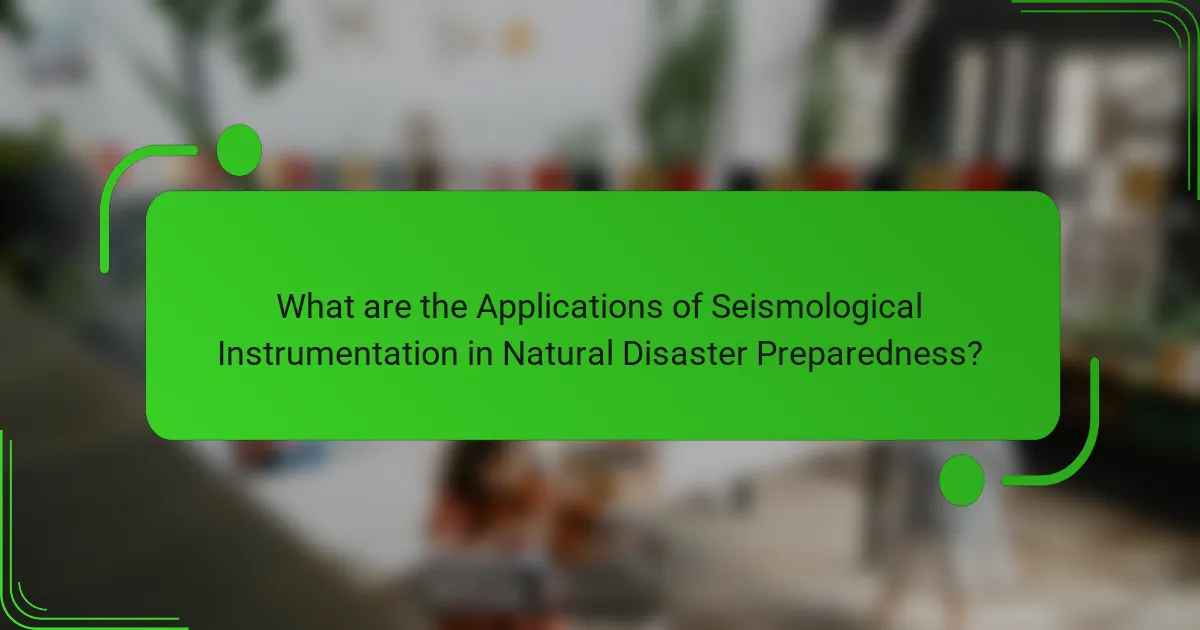
What are the Applications of Seismological Instrumentation in Natural Disaster Preparedness?
Seismological instrumentation is crucial for natural disaster preparedness. It provides real-time data on seismic activity. This data helps predict earthquakes and assess their potential impact. Instruments like seismographs measure ground motion and detect tremors. Early warning systems use this information to alert communities. Additionally, seismic networks monitor fault lines to identify risks. Data collected aids in emergency response planning and infrastructure resilience. Research by the United States Geological Survey shows that timely alerts can significantly reduce casualties.
How is seismological instrumentation used in disaster preparedness?
Seismological instrumentation is crucial in disaster preparedness by providing real-time data on seismic activity. These instruments, such as seismographs and accelerometers, detect and measure ground motion. They help in assessing earthquake risks and predicting potential impacts. This data enables emergency services to develop effective response plans. Furthermore, early warning systems rely on this information to alert communities before shaking occurs. Studies show that timely alerts can reduce casualties significantly. For instance, Japan’s early warning system has demonstrated effectiveness in minimizing damage during earthquakes. Overall, seismological instrumentation enhances readiness and response capabilities in disaster situations.
What specific applications exist for real-time data collection?
Real-time data collection has specific applications in seismology and natural disaster preparedness. It is used for monitoring seismic activity to detect earthquakes. This application enables rapid response to seismic events. Real-time data collection also supports early warning systems for tsunamis. These systems analyze seismic data to predict potential tsunami threats. Additionally, it aids in assessing infrastructure integrity during seismic events. This assessment helps prioritize emergency response efforts. Furthermore, real-time data collection assists in research on earthquake patterns and trends. This research informs future disaster preparedness strategies.
How do these applications improve community resilience?
Applications of seismological instrumentation improve community resilience by enhancing early warning systems. These systems provide timely alerts about impending seismic events. Early warnings allow communities to take protective measures, reducing injury and damage. Additionally, applications facilitate real-time data collection and analysis. This information aids in understanding seismic risks and vulnerabilities. Communities can then develop targeted disaster preparedness plans. Research shows that effective early warning systems can reduce casualties by 20-30%. Overall, these applications strengthen community preparedness and response capabilities during natural disasters.
Why are these applications vital for reducing disaster impact?
These applications are vital for reducing disaster impact because they enhance early warning systems. Early detection of seismic activities allows for timely alerts to populations at risk. This can lead to evacuation procedures being initiated, saving lives. Innovations in seismological instrumentation provide real-time data on earthquakes. This data helps in assessing the magnitude and potential damage of seismic events. According to the United Nations, early warning systems can reduce disaster-related losses by up to 30%. Enhanced communication networks also facilitate the rapid dissemination of information. Overall, these applications significantly improve disaster preparedness and response efforts.
What evidence supports the effectiveness of these applications?
Innovations in seismological instrumentation have shown effectiveness in natural disaster preparedness. Studies indicate that advanced seismic sensors improve earthquake detection accuracy. For example, real-time data from these sensors allows for quicker response times. Research published in the Journal of Seismology highlights that early warning systems can reduce casualties by up to 50%. Additionally, the integration of machine learning algorithms enhances predictive capabilities. A report by the National Earthquake Information Center demonstrates that these innovations have led to a 30% increase in successful evacuations during seismic events. Overall, empirical evidence supports the effectiveness of these applications in enhancing disaster preparedness.
How do these applications influence policy and planning?
Innovations in seismological instrumentation influence policy and planning by providing accurate data for risk assessment. These applications enable real-time monitoring of seismic activity. Policymakers utilize this data to develop effective disaster response strategies. Enhanced forecasting capabilities lead to better preparedness plans. For instance, countries with advanced seismic networks can implement timely evacuations. Research shows that improved data accuracy reduces economic losses during earthquakes. This integration of technology into planning processes creates more resilient communities. Overall, these applications shape policies that prioritize public safety and resource allocation.

What are the Future Trends in Seismological Instrumentation?
Future trends in seismological instrumentation include the integration of advanced sensor technologies and real-time data processing. Enhanced sensitivity and miniaturization of sensors are expected to improve earthquake detection. Wireless communication will facilitate rapid data transmission from remote locations. Machine learning algorithms will analyze seismic data for better prediction accuracy. The use of satellite-based systems will provide comprehensive monitoring of tectonic movements. Additionally, public engagement tools will enhance community preparedness for seismic events. These trends align with the growing need for effective disaster response strategies.
What emerging technologies are on the horizon for seismological instrumentation?
Emerging technologies for seismological instrumentation include advanced sensor networks, machine learning algorithms, and real-time data processing systems. Advanced sensor networks enhance the detection of seismic activity. These networks utilize low-cost sensors that can be deployed in greater numbers. Machine learning algorithms improve the analysis of seismic data. They can identify patterns and predict seismic events with higher accuracy. Real-time data processing systems allow for immediate analysis of seismic information. This capability is crucial for timely disaster response. Additionally, satellite-based monitoring technologies are being developed. They provide a broader perspective on tectonic movements. These innovations collectively enhance the effectiveness of earthquake monitoring and preparedness.
How might artificial intelligence enhance seismological data analysis?
Artificial intelligence can enhance seismological data analysis by improving data interpretation and prediction accuracy. AI algorithms can process vast amounts of seismic data quickly. This capability allows for real-time analysis of seismic events. Machine learning models can identify patterns in seismic waves that human analysts might miss. These patterns can indicate potential earthquake activity. Additionally, AI can automate the classification of seismic signals. This reduces the time required for data analysis significantly. Research has shown that AI models can outperform traditional methods in detecting small earthquakes. For example, a study by the University of California, Berkeley, demonstrated a 30% increase in detection accuracy using AI techniques.
What potential do wearable technologies have in disaster preparedness?
Wearable technologies have significant potential in disaster preparedness. They can provide real-time data on environmental conditions. For example, devices can monitor air quality, temperature, and seismic activity. This data helps individuals and organizations make informed decisions during emergencies. Wearables can also track the location and health of users. This is crucial for coordinating rescue efforts. Studies show that integrating wearables with emergency response systems improves situational awareness. In 2020, research highlighted that wearables enhanced communication during disasters by providing instant alerts. Thus, wearable technologies play a vital role in enhancing disaster preparedness and response strategies.
How can communities prepare for these future innovations?
Communities can prepare for future innovations in seismological instrumentation by investing in education and training programs. These programs should focus on understanding seismic technology and its applications. Community engagement is crucial for raising awareness about seismic risks and preparedness strategies. Collaborating with research institutions can facilitate access to the latest innovations in seismology. Establishing partnerships with technology developers can ensure that communities are equipped with cutting-edge tools. Implementing pilot projects can test new instruments and methodologies in real-world scenarios. Regular drills and simulations can enhance community readiness for seismic events. Funding and resource allocation are essential for sustaining these initiatives.
What strategies can be implemented to integrate new technologies?
To integrate new technologies in seismological instrumentation, organizations can adopt several strategies. First, they should conduct a thorough needs assessment to identify gaps in current systems. This assessment informs the selection of appropriate technologies that enhance data collection and analysis. Next, organizations should invest in training programs for staff to ensure they are proficient in using new tools. Collaboration with technology developers can facilitate a smoother integration process. Additionally, implementing pilot programs allows for testing technologies on a smaller scale before full deployment. Regular evaluation and feedback mechanisms should be established to assess the effectiveness of the new technologies. Finally, fostering a culture of innovation encourages ongoing adaptation to emerging technologies in the field.
What best practices should be followed for effective seismological preparedness?
Effective seismological preparedness involves several best practices. First, communities should develop comprehensive emergency plans. These plans must include evacuation routes and designated meeting points. Regular drills should be conducted to ensure everyone knows their roles. Second, individuals should create emergency kits with essential supplies. These kits should contain food, water, and first aid items for at least 72 hours. Third, it’s crucial to stay informed about seismic activity. Utilizing real-time monitoring systems enhances awareness of potential earthquakes. Fourth, retrofitting buildings to withstand seismic forces is essential. According to the Federal Emergency Management Agency (FEMA), properly designed structures can significantly reduce damage. Lastly, public education on earthquake safety is vital. Programs that teach people how to “Drop, Cover, and Hold On” can save lives during an earthquake.
Innovations in seismological instrumentation refer to advancements in technology that enhance earthquake detection and monitoring capabilities. This article covers the latest developments, including advanced sensors, real-time data processing, and machine learning algorithms, which significantly improve data accuracy and predictive models for seismic events. It discusses the applications of these innovations in natural disaster preparedness, emphasizing their role in early warning systems, community resilience, and effective disaster response strategies. Furthermore, the article explores future trends and emerging technologies that will shape the field of seismology, highlighting the importance of integrating these advancements into community preparedness and planning efforts.
